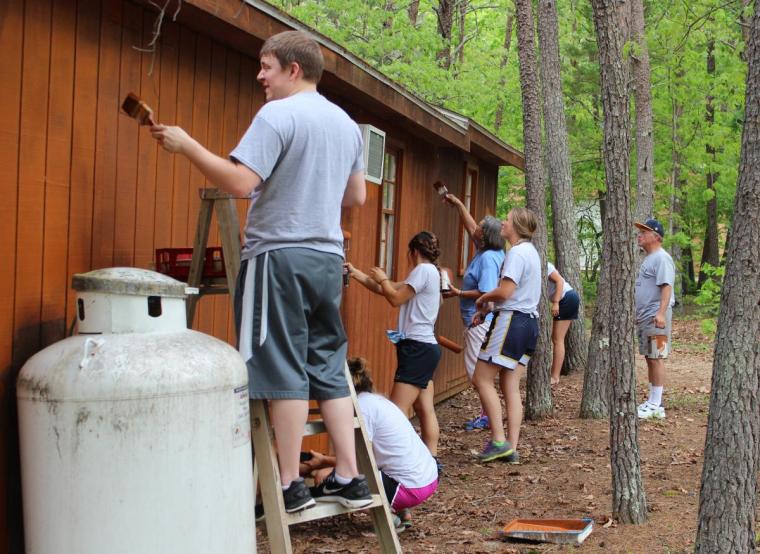

And there’s a word for that: voluntourism: a hybrid activity that harnesses the ability to travel with the ability to try to make a positive change in the environment you're visiting.
Think: traveling to a city and taking a few hours to help revitalize a playground. Think: flying in for a convention and spending the morning cleaning up a stream.
In other words, it’s not all about you. In fact, it’s a growing movement with the overriding goal of making a positive change.
With ‘growing’ being the operative word. Travel Weekly reports that more than half of Americans who traveled in the past two years either volunteered or made a charitable donation to a place they visited, according to a study released two weeks ago.
And now, that trend is taking hold of the sports event planning economy, where it is more than a passing fad. For years, sports teams and players in national tournaments have made a practice of reaching out to the local communities they are visiting by offering sport skill clinics for children, special lessons for combat-wounded military veterans and more. And these sessions have played out in pools, on ice rinks, on tennis courts and on running tracks and sports fields around the U.S. The MISL Baltimore Blast, for example, notes that it has performed skill clinics, camps and motivational programs for children from disadvantaged backgrounds.
These days, you’re likely to see an even deeper level of involvement, and athletes are riding the crest of that wave, doing outreach in areas far outside their home turf.
The National Christian College Athletic Association (NCCAA) schedules community service days each time it travels out of town for a national tournament. In fact, every team member is expected to participate.
“We want the kids to learn to do more than compete,” says Dan Wood, executive director of NCCAA. “We want them to figure that service to the world around you should come first. It’s easy to lose sight of that post-season and say, ‘I’ll get back to that when play-offs are over’ but that’s not what we want. We want kids to think, ‘What would Jesus do?’ Well, He wouldn’t be standing around on a street corner, passing out religious tracts. Our kids have worked in soup kitchens and done landscaping work in the community. In one city, they went around to a low-income community, distributing high-tech light bulbs and changing out the old bulbs in people’s homes if they needed that done.”
USA Field Hockey’s Kait Mitchell has noted that her organization also has a strong community mindset. The national team has woven the importance of giving back into their culture by volunteering at events and with organizations in the local Lancaster, Pennsylvania, area, including working at community fairs, visiting children’s hospitals and more. It also seeks out opportunities in other areas.
Attribute it to an outcropping of good sportsmanship, or perhaps the ingrained teamwork ethic that comes with a sports background. Either way, it’s a benefit to the host city – and most assuredly a change from the image of a self-absorbed athlete or tourist. In fact, the survey quoted in Travel Weekly noted that many travelers simply don’t feel right unless they can do something to benefit the area they're visiting and enjoying.
“Giving back in some way — formally or informally — is ingrained in the value system of most U.S. travelers,” according to the study, which was conducted by travel researcher Phocuswright on behalf of the U.S. travel industry-supported nonprofit Tourism Cares. “At home or in far-flung destinations, many travelers give back as a matter of course, in a way that is meaningful and convenient to them.”
The study’s sample consisted of 2,551 online respondents, each of whom had a household income of at least $50,000 and had traveled more than 75 miles from home in the past two years. Among those who said that they had donated, 48% said that it was either “very important” or “extremely important” that their travel spending benefit the communities they visit. In addition, 64% said that giving back contributed strongly to the satisfaction of their trip while 34% said that commitment to social responsibility was a factor in their choice of a travel company.
In fact, a whole industry has sprung up around voluntourism (Googling the term will bring up a host of tour operators and informational sites). But for those whose schedules preclude volunteer work, there are still plenty of options to give back, according to Independent Traveler. And one of those is the old standard: buying local (including booking awards banquets at independent restaurants rather than at chain hotels, and using local vendors to order merchandise such as T-shirts and trophies), so that money spent has maximum community impact. In addition, the Game Day Recycling Challenge, which pits colleges against one another, allows visitors to get into the spirit easily by putting glass bottles and other recyclables into special bins at the end of football games. At the end of the season, colleges' collective tonnage of recycled materials is compiled and one is declared the Game Day Recycling Challenge champion. (For planners who want to design ways to make their event green, there's this handy guide.)
Millennials (age 18-34), often referred to as the 'me' generation, are at the forefront of the movement to give back in travel, noted Travel Weekly. They're also the growing market for sports travel. And right behind them is another strong sports travel market: families, who volunteered for 38 hours on their most meaningful trip, a total of 12 hours more than survey respondents over the previous two years.

